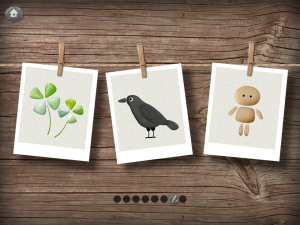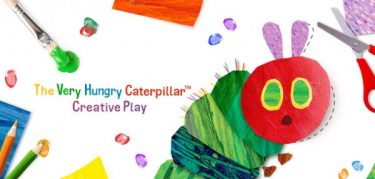Maker Apps? Why not? | Touch and Go

From Apprentice Architect (Fondation Louis Vuitton/Touch Press)

Christoph Niemann’s CHOMP (Fox & Sheep GmbH/Jon Huang)

The Complete Fairytale Play Theater (Nosy Crow)
Fans of Nosy Crow can now create stories featuring the developer’s characters with The Complete Fairytale Play Theater (iOS, $4.99; Free, PreS-Gr 4). After selecting one of the six stories from the list of tales the company has produced (Goldilocks and Little Bear, Snow White, Jack and the Beanstalk, Little Red Riding Hood, Cinderella, or The Three Little Pigs), children choose a setting from a menu bar. The 10 settings include a castle, cottages, a beanstalk, and a forest, among others; all are illustrated in vibrant colors. To add figures, viewers tap and drag from the developer’s cast of cartoon characters. Mixing and matching figures and creatures from different stories is possible, allowing kids to create fractured fairytales. An array of props provides story accessories, and 11 options for background music set the mood. The app is easy to navigate (preschoolers shouldn’t have a problem), but short tutorials on setting the stage, moving the camera, recording and playing, etc., are available. Once the scene, characters, and music have been selected, children may choose to narrate and record the story, moving the characters about as they do so. In the finished product, the characters’ mouths move to the recorded words, providing a cinematic feel to the tale. Older children may want to add multiple scenes to create more complex stories. Completed tales are saved within the app, but currently there is no way to share the stories outside the environment. The Complete Fairytale Play Theater is a superb storytelling tool that encourages children to express themselves, and it’s likely to draw repeat visits from children who love to create, imagine, and perform.–Cathy Potter, Falmouth Elementary School, Falmouth, ME
Build and collect robot creations in The Robot Factory (Tinybop, Inc.) illus. by Owen Davey
Tinybop’s “Digital Toys” collection— Everything Machine , Monsters, Robot Factory—offers kids the tools (multiple appendages, gadgets, and gizmos”) to build, test, play, and save creations. And the numbers are astounding; as of last spring kids have designed more than 5.2 million robots and created more than 120,000 machines.
In Everything Machine (iOS; $2.99), users can make a range of simple to sophisticated machines using their iPad's camera, microphone, gyroscope, and other features, and connect to other devices if they like. Sample inventions are offered and a downloadable “technical” manual provides details on the different parts to experiment with (with labels in more than 40 languages), along with instructions on how to use them.
For Monsters (i0S, $2.99), the developers spoke with to kids around the world to discover that while the concept of monster varied, one thing shared across cultures was the fear of scary things in the night. Noting that people create their own monsters, the developer states, “This app does the same thing. The Monsters gives kids agency over their fears, allowing them to make monsters of their own in a variety of settings. And to cast them away, if they wish.” Design options include scales, horns, feathers, fur, or sparkles, and an assortment of eyes, mouths, and appendages. Animations, voices, and sound are additional options. Offering users 100 "exoskeletons, zephyr mechanisms, hydrostatic tentacles, machinos locomotors, G-Force mixers, and other parts to play with," The Robot Factory (iOS, currently free; Gr 1 Up) provides children with everything they need to make robots of all shapes, sizes, and themes. "Robot cats. Robot samurais," and the list goes on. In addition, users can add sound effects and save their creations. All Tinybop apps are available in multiple languages and downloadable manuals are available on their website. Perfect for young children, Labo Leaves (Labo Lado Inc. iOS S1.99, Android $.99; PreS-K) provides users with 18 design templates. Each screen in the app presents four to seven colorful leaves of various shapes, sizes, and colors that children can drag to the correct (outlined) spot to create a figure or a familiar creature such as a fish, pig, dog, chicken, or cow. When the picture is completed correctly, users are rewarded with a short, humorous animation. There is no text or narration to this crisply designed app, but a soothing melody plays in the background and the animated sequences feature sound effects. Arrows direct users how and where to turn the page; the rest is intuitive. Adults who work with children may want to use the app as a starting point for hands-on preschool art and science projects. For youngsters, hand-eye coordination and fine-motor skills come into play. The app is user-friendly and no Internet connection is necessary once it is downloaded. A strong addition to the Labo Lado’s collection of creative apps. Available in several languages.–Amy Shepherd, Librarian, St. Anne’s Episcopal School
From Labo's Pebble Art ( Labo Lado)
A clothesline row of 22 pictures greets children on opening Labo’s Pebble Art (Labo Lado, iOS, $1.99, Android, $2.06; PreS-Gr 1). After selecting an image with a tap, viewers are brought to a screen where the picture has been deconstructed. Their job is to reassemble the image puzzle fashion; a grey outline is provided. The shapes are large and few, so the task is not particularly difficult but it will call in young children’s visual discrimination and fine-motor skills. Once the image is complete, a palette of bright colors becomes available (along with a thumbnail image of a painted image). Children can color the image by finger if they desire; a tap to a check mark icon indicates the painting is complete. Behind each finished painting is a related animated scene or game that incorporates the picture the appster has just completed. A blackbird walks along a grassy landscape seeking worms (some more dangerous than others), a caterpillar becomes a xylophone capable of creating a tune, and a screen floods with colorful beetles of different colors, sizes, and body types that when matched with its pair tallies into points discreetly noted in a corner of the screen. While most kids won’t even notice the points accumulating, the games are timed. At the end of each one, confetti drops and a final score is noted. The app contains no narration, but background music accompanies the activities and some of the games incorporate their own songs or tunes. Simple, clean images, smooth functionality, and a variety of charming animations and delightfully inventive activities will keep kids coming back for more. Available in six languages.—Daryl Grabarek, School Library Journal
Millie Marotta’s Coloring Adventure (Touchpress/Batsford) Marotta
Now, along comes Millie Marotta’s Coloring Adventure (Touchpress/Batsford; iOS, Free; Gr 3 and Up) for the iPad, and it looks like the trend has successfully made the leap to digital. The developer notes that “after just one week” the app was downloaded 100,000 times. Whether or not you believe in the restorative power of the act of coloring, the starter pack is free and worth a try.
Marotta is the author of two coloring books, and by her own account, has a “mild obsession with all things flora and fauna.” Characteristic of her artwork are images featuring “intricate patterns” and splashes of color. The app offers five pictures to paint and a palette of colors to choose from; tones can be adjusted. Artists can color by finger (the zoom-in feature helps), but any hope (or desire) of staying within the lines requires an iPad-compatible stylus, with the Apple Pencil (on iPad Pro) recommended. Users can start over or erase if they are not satisfied with their work, and masterpieces can be saved and/or shared with friends and family on Twitter, Instagram, or Facebook. The app is available in a number of languages. Coming soon are “Birds” and “Botanical”—add-on packs of pictures to purchase. A trailer is available.—Daryl Grabarek, School Library Journal
Skyscrapers (Tinybop, Inc.) illus. by Mike Ellis
“Sparking curiosity, diving into big ideas, and making connections to the world,” are design objectives of the innovative developer Tinybop, Inc., and all are in evidence in Skyscrapers (iOS, $2.99; K -Gr 5), the seventh volume in their “Explorer’s Library” series. Like the other apps in the series (Plants, Homes, Human Body, Simple Machines, Weather, and The Earth), there are no instructions or directions; children are encouraged to dig in and play to discover how the app and the environment work. In Skyscrapers, the form and structure of the buildings can be altered and the water and electrical systems activated; a side panel allows for access to these and other functions. A variety of facades (curtain walls) and spires are available along with a palette of colors as children customize their buildings and develop a skyline. As they do so, they’ll observe how adding floors (commercial or residential) causes the depth of a building’s foundation to increase and flights of stairs to be added, etc. Inside the buildings, they’ll be thrilled to discover they can move figures about to ride the elevators and use the lavatories. A tap to an icon allows for several up-close system views: in one, children can watch as an electricity meter rises and falls when they switch lights and appliances off and on. In another, they can observe how and where water drains and what happens when a foreign object (a rubber ducky) clogs the plumbing. (They can also activate the repair.) Equally fascinating is watching the environmental effects of lightning, wind, or an earthquake on a building. Wind will cause it to sway; an earthquake causes it to shake, while sparking an electrical storm will cause lightning to strike the lightning rod (and travel down the structure to a grounding rod beneath the building). In buildings 18 floors or taller, viewers can install a “mass damper” and see how it alleviates environmental effects on a building. Ambient sounds (moving elevators, thunder, etc.) are heard as figures travel about the building and the weather outside changes. Whimsy enters, too: children can add elephants or massive rocks to the floors (the added weight impacts the building’s foundation) and hot-air balloons float across the sky, along with a small plane trailing the player’s name on a banner. As with other Tinybop apps, extended play rewards viewers, who will want to return again and again to add or subtract to their skylines. While there are no directions, there are labels with options for five languages. In addition, a free online PDF offers detailed background notes, including discussion questions—a boon to teachers and homeschooling parents. The Tinybop blog offers more information on the app’s design and an interview with the illustrator Mike Ellis. A trailer is also available.—Daryl Grabarek, School Library Journal
Sock Puppets (Smith Micro Software, Inc.)
Lip-synched puppet shows anyone? With Sock Puppets it’s both quick and easy (Smith Micro Software, Inc. iOS, free to download, "complete pass" IAP $2.99; PreS-Gr1). On opening the app children are offered any number of characters to work with, from amorphous aliens in a variety of neon colors to Halloween-themed creatures to “real” socks with animal or cartoon features. Next to select are backgrounds, props, and scenery, either related to the characters viewers have chosen (spider webs, a haunted house, etc., for Halloween or planetary landscapes and space ships for the aliens, and so on), or, if they prefer, they can mix and match themes. Once choices are made, it's time to record a voice sample that can be adjusted high or low for each character, creating delightful voice distortions that promise to be nearly as much fun for users as moving their puppets in the various environments and creating a show. When ready to go, a tap to the puppet will have it lip-synching to the narrator's voice.—Daryl Grabarek, School Library Journal
The Very Hungry Caterpillar: Creative Play (StoryToys Entertainment)
Young children will have hours of fun experimenting with colors, textures, and shapes in The Very Hungry Caterpillar: Creative Play (StoryToys Entertainment, iOS, $2.99, Android, IAPs; PreS-K), the latest in the suite of apps inspired by Eric Carle’s iconic picture books. The app includes 20 templates featuring characters from Carle’s works including Brown Bear, Mr. Seahorse, and the Mixed-Up Chameleon. Navigation is intuitive. A menu at the top of the screen provides users with options for drawing, painting, or creating collage art. Kids can tap the scissors for cut-paper collage mode, touch the brush to paint, or select the pencil for drawing. The menu includes an impressive array of textures, patterns, and colors from which to choose. Collage art in the style of Carle is created by tracing dotted lines on the template to add various patterns of paper to the page, an activity that also provides an opportunity for users to exercise their hand-eye coordination. Background music can be switched on and off; on, the music provides a soothing ambiance for young artists. Children who wish to create their own pictures may choose a blank canvas instead of the templates. As they work, a curved arrow serves as an undo button allowing them to clear their work one step at a time in both drawing and painting modes. There’s also the option to save pictures to a gallery or the iPad’s camera roll. Creative Play will encourage young children to imagine, illustrate, and possibly write as they create their own masterpieces; its simplicity belies its possibilities. And, after spending time with some of their favorite characters, children just may be inspired to revisit their favorite Carle books. Language options are available, as is a trailer.—Cathy Potter, Falmouth Elementary School, Falmouth, MEFor additional app reviews, visit School Library Journal's dedicated app webpage.
RELATED
The job outlook in 2030: Librarians will be in demand
The job outlook in 2030: Librarians will be in demand
ALREADY A SUBSCRIBER? LOG IN
We are currently offering this content for free. Sign up now to activate your personal profile, where you can save articles for future viewing






Add Comment :-
Comment Policy:
Comment should not be empty !!!
Cke
*applePosted : Jun 08, 2017 06:15
Cke
Any recommendations that don't rely on Ape devices??Posted : Jun 08, 2017 06:15